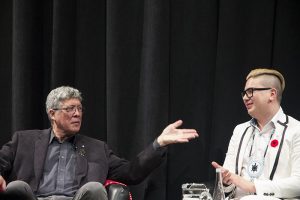BY SAMANTHA MOYA
Imagine being sprayed with water cannons by police in below freezing weather. Being hit by rubber bullets and rounds of tear gas. This is the type of treatment the protesters of the North Dakota Access Pipeline face on the frontline. A confrontation that happened Sunday night left 200 injured and sent 12 people to hospital after protesting the pipeline.
If completed, the pipeline would run from North Dakota to Illinois, almost 2,000 kilometres. It would run across landscapes, farms and waterways, including the Mississippi River, a water source to thousands of people creating a huge risk to a way of life, mainly for Native Americans.
There are many people in solidarity with the protestors, and they are finding other ways to shine light on the issue. Facebook check-ins to the camp and solidarity protests happening in major cities demonstrates the importance of this issue to many, including Sheridan College students.
The growing violence around the issue is shocking to see, but it is not a surprise to everyone.
“It’s just another scare tactic. It’s something we’ve seen over history happen to indigenous peoples,” said Elijah Williams, a research assistant for the Centre of Indigenous Learning and Support. “There’s a big violation of human rights out there. There’s a huge environmental impact on the world too.”

Although there is violence, peaceful protests have been successful as well. Toronto’s #NODAPL solidarity march brought out thousands of protesters. On November fifth they marched through the streets of downtown from Queens Park to Nathan Phillips Square. Justine Geroche is an environment and policy student at UofT Scarborough, she was in attendance of the protest. popular sign I saw held by many activists consisted of three words: We Are Water. It highlights the cultural and environmental importance in the fight against the facilitation of DAPL,” she said.

There is a great divide but this issue has also created unity throughout Indigenous peoples and thousands of allies. Williams said, “its bringing all of our nations together. its always a good to see people working together and supporting each other on these issues because it really affects us all.” As American Thanksgiving approaches, which originally is a celebration of peace between Native Americans and the colonizers, protestors and allies can only hope for a peaceful resolution to an ongoing issue.
“A popular sign I saw held by many activists consisted of three words: We Are Water. It highlights the cultural and environmental importance in the fight against the facilitation of DAPL,” she said.
There is a great divide but this issue has also created unity throughout Indigenous peoples and thousands of allies. Williams said, “it’s bringing all of our nations together. its always a good to see people working together and supporting each other on these issues because it really affects us all.”
